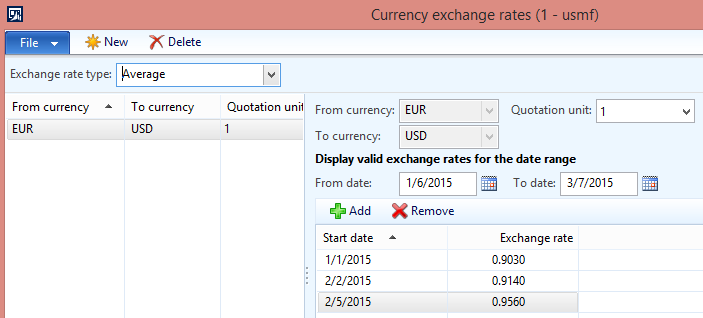Adding Exchange Rates using the AIF LedgerExchangeRateService Service
The following is a quick example that may help if you need to add an Exchange Rate to an existing Currency Pair in Microsoft Dynamics AX 2012 R3 using the AIF LedgerExchangeRateService service. I ran into a couple snags along the way and finally was able to insert data correctly in AX using the below. When you create the AIF Inbound Port for this service, I recommend to enable logging under the Troubleshooting section in case you need to review the XML that is created.
C# Console Application Example
The goal in the support case was to add an Exchange Rate to at an already existing Currency Pair (EUR to USD) pair.
The code below adds a new Exchange Rate to this existing Currency Pair.
using System;
using System.Collections.Generic;
using System.Linq;
using System.Text;
using System.Threading.Tasks;
using UpdateExchangeRateTester.ERService;
namespace UpdateExchangeRateTester
{
class Program
{
static void Main(string[] args)
{
ExchangeRateServiceClient proxy = new ExchangeRateServiceClient();
CallContext cc = new CallContext();
cc.Company = “USMF”;
// Call Read First per http://community.dynamics.com/ax/f/33/t/75714.aspx
//Criteria will be the From and To for the CurrencyPair (EUR to USD)
QueryCriteria qc = new QueryCriteria();
qc.CriteriaElement = new CriteriaElement[2];
qc.CriteriaElement[0] = new CriteriaElement();
qc.CriteriaElement[0].FieldName = “FromCurrencyCode”;
qc.CriteriaElement[0].DataSourceName = “CurrencyPair”;
qc.CriteriaElement[0].Value1 = “EUR”;
qc.CriteriaElement[1] = new CriteriaElement();
qc.CriteriaElement[1].FieldName = “ToCurrencyCode”;
qc.CriteriaElement[1].DataSourceName = “CurrencyPair”;
qc.CriteriaElement[1].Value1 = “USD”;
EntityKey[] keylist = proxy.findKeys(cc, qc);
AxdLedgerExchangeRate axdExchangeRate = proxy.read(cc, keylist);
foreach (AxdEntity_CurrencyPair currencyPair in axdExchangeRate.CurrencyPair)
{
currencyPair.action = AxdEnum_AxdEntityAction.update;
currencyPair.actionSpecified = true;
currencyPair.RateType = null; // do not send in a CurrencyPair RateType on updates
//create new exchange rate
AxdEntity_ExchangeRate newExchangeRate = new AxdEntity_ExchangeRate();
newExchangeRate.ExchangeRate = 95.60M; //AX value is .95600
newExchangeRate.ExchangeRateSpecified = true;
newExchangeRate.ValidFrom = new DateTime(2015, 2, 5);
newExchangeRate.ValidFromSpecified = true;
newExchangeRate.action = AxdEnum_AxdEntityAction.create;
newExchangeRate.actionSpecified = true;
currencyPair.ExchangeRate = new AxdEntity_ExchangeRate[1] { newExchangeRate };
}
try
{
proxy.update(cc, keylist, axdExchangeRate);
Console.WriteLine(“Update Call Complete”);
}
catch (Exception e)
{
Console.WriteLine(e.Message);
Console.WriteLine(“The AxdLedgerExchangeRate was not updated.”);
}
Console.ReadLine();
}
}
}
A couple items I had to do was set the RateType to null on the AxdEntity_CurrencyPair object otherwise I was receiving an AIF Exception on RateType. I also did not send the existing Exchange Rate data in the AxdEntity_ExchangeRate[] collection.I just created a new AxdEntity_ExchangeRate with the action property set to create. The final result looks like what I wanted to achieve with a new Exchange Rate added with correct dates:
XML Example
This is the XML document that AIF processes from the C# Console Application. You can use this as a starting point if you need to know what the XML schema should look like if you need to create XML for a File Adapter Inbound port.
<?xml version=”1.0″ encoding=”UTF-8″?>
<ExchangeRateServiceUpdateRequest xmlns=”http://schemas.microsoft.com/dynamics/2008/01/services“>
<EntityKeyList xmlns=”http://schemas.microsoft.com/dynamics/2006/02/documents/EntityKeyList“>
<EntityKey xmlns=”http://schemas.microsoft.com/dynamics/2006/02/documents/EntityKey“>
<KeyData>
<KeyField>
<Field>RecId</Field>
<Value>22565423204</Value>
</KeyField>
</KeyData>
</EntityKey>
</EntityKeyList>
<LedgerExchangeRate xmlns=”http://schemas.microsoft.com/dynamics/2008/01/documents/LedgerExchangeRate“>
<DocPurpose>Original</DocPurpose>
<SenderId>USMF</SenderId>
<ValidAsOfDateTime>2015-02-05T00:00:00Z</ValidAsOfDateTime>
<ValidFromDateTime xsi:nil=”true” xmlns:xsi=”http://www.w3.org/2001/XMLSchema-instance”></ValidFromDateTime>
<ValidTimeStateType>AsOf</ValidTimeStateType>
<ValidToDateTime xsi:nil=”true” xmlns:xsi=”http://www.w3.org/2001/XMLSchema-instance”></ValidToDateTime>
<CurrencyPair class=”entity” action=”update”>
<_DocumentHash>911f6653fc2da5d3ce42d69fb95f7269</_DocumentHash>
<RecId>22565423204</RecId>
<RecVersion>1</RecVersion>
<FromCurrencyCode>EUR</FromCurrencyCode>
<ToCurrencyCode>USD</ToCurrencyCode>
<ExchangeRateType>Average</ExchangeRateType>
<ExchangeRateDisplayFactor>One</ExchangeRateDisplayFactor>
<ExchangeRate class=”entity” action=”create”>
<ExchangeRate>95.60</ExchangeRate>
<ValidFrom>2015-02-05</ValidFrom>
</ExchangeRate>
</CurrencyPair>
</LedgerExchangeRate>
</ExchangeRateServiceUpdateRequest>





